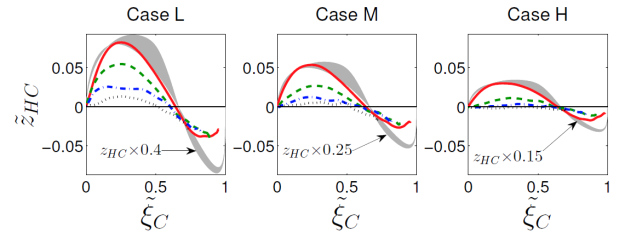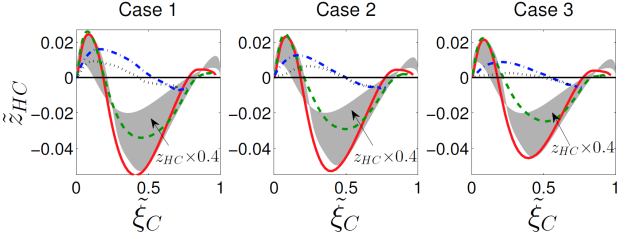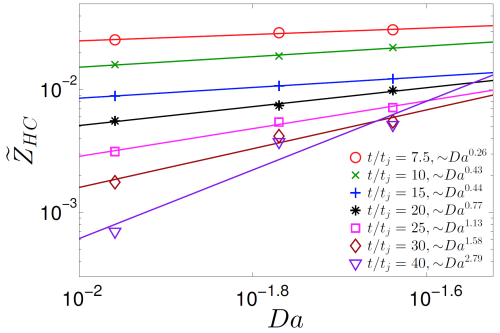Reports: DNI953781-DNI9: Study of Detailed Molecular Transport in Laminar Flamelet and Turbulent Non-Premixed Combustion
Haifeng Wang, PhD, Purdue University
1. Overview
The aim of this project is to develop quantitative understanding of differential molecular diffusion in turbulent non-premixed flames by interrogating DNS flames from Sandia National Lab. Two DNS flames are considered in the work to study the physical behaviors and the scaling of the differential molecular diffusion with respect to the Reynolds number Re and the Damkohler number Da. One DNS flame uses CO/H2 as the fuel, and the other flame uses C2H4 as the fuel. Three cases are considered in the CO/H2 DNS flames, case L, case M, and case H, with increasing Re and with the same Da. The C2H4 DNS flames have three cases as well, case 1, case 2, and case 3, with decreasing Da and with the same Re. These DNS flames provide accessible information for studying differential molecular diffusion in turbulent non-premixed combustion. The knowledge gained from this study is critically important in guiding future development and validation of new differential molecular diffusion models.
2. Different Differential Molecular Diffusion Behaviors
The differential molecular diffusion behaviors in the two DNS flames are examined. The differential molecular diffusion behaviors in the laminar flamelets are used as a reference to examine the difference of the two DNS flames in terms of the fundamental differential molecular diffusion behaviors. The differential molecular diffusion is quantified by zHC which is the difference of the mixture fractions (zHC=ξH- ξC) defined based the different elements of H and C. Figure 2 shows zHC against ξC in the three CO/H2 DNS flames, case L, case M and case H. A characteristic similarity of the differential molecular diffusion behaviors in DNS and in the flamelet solutions can be observed from the figure. The similarity indicates that the effect of differential molecular diffusion in the CO/H2 DNS flames can probably be captured by flamelet models. We call this type of differential molecular diffusion behavior in the CO/H2 DNS flames “flamelet-like”.
In contrast, the differential molecular diffusion behaviors in the C2H4 DNS flames are qualitatively different as shown in Figure 2 which shows zHC against ξC in the three C2H4 DNS flames, case 1, case 2 and case 3. Except at early time, zHC from the DNS flames are qualitatively different than zHC from the flamelet solutions, particularly at the conditions where zHC changes sign. This difference indicates the differential molecular diffusion behaviors in the C2H4 DNS flames are different from those in the CO/H2 DNS flames when the steady laminar flamelet solutions are used as references. As a result, it is expected that the flamelet models are unlikely able to reproduce differential molecular diffusion in the C2H4 DNS flames. We call this type of differential molecular diffusion behaviors in the C2H4 DNS flames “non-flamelet-like”. This imposes additional challenges to the development of differential molecular diffusion models because of the existence of the different types of differential molecular diffusion behaviors.
Figure 1. Profiles of zHC against ξC in the three CO/H2 DNS flames, case L (left), case M (middle), and case H (right), at t/tj=10 (solid lines), at t/tj =15 (dashed lines), at t/tj =20 (dash-dotted lines), at t/tj =30 (dotted lines). The shaded area covers the steady flamelet solutions which are scaled by a factor of 0.4, 0.25 and 0.15, respectively.
Figure 2. Profiles of zHC against ξC in the three C2H4 DNS flames, case 1 (left), case 2 (middle), and case 3 (right), at t/tj =7.5 (solid lines), at t/tj =10 (dashed lines), at t/tj =20 (dash-dotted lines), at t/tj =30 (dotted lines). The shaded area covers the steady flamelet solutions which are scaled by a factor of 0.4.
3. Scaling of Differential Molecular Diffusion
The understanding and quantification of scaling the differential molecular diffusion with respect to key dimensionless numbers are important to the development of new models that are able replicate key physics of differential molecular diffusion. The scaling of differential molecular diffusion with respect to Re and Da is quantified in this work.
The Re scaling of differential molecular diffusion is examined in the three CO/H2 DNS flames as shown in Figure 3. In the figure, the collapse of the DNS results (shown as symbols) along a straight line in the log-log plot is excellent, indicating a scaling of zHC~Rea, where a is a positive constant. The value of a depends on time in the DNS flames and varies between 0.76 and 1.38 at the different times shown in the figure.
Figure 3. Re scaling of differential molecular diffusion in the CO/H2 DNS flames
The Da scaling is explored in the three C2H4 DNS flames as shown in Figures 4. The results in the figures show a strong power law scaling with respect to the Da, zHC~Daa with a being a constant. This newly discovered scaling need to be incorporated in differential molecular diffusion models to replicate the scaling observed in the DNS flames.
Figure 4. Da scaling of differential molecular diffusion in the C2H4 DNS flames
4. Impact of the Research
The knowledge gained from this research has the follow impacts:
· The discovered behavior difference of differential molecular diffusion in different flames signifies the importance of thorough understanding of the physical phenomenon. It exposes the limitation of flamelet type of models to treat differential molecular diffusion.
· The quantified scaling of differential molecular diffusion with respected to Re and Da provides assessable criteria for developing and validating new physics based models for differential molecular diffusion.
· The grant assists the career development of the PI towards his goal of developing predictive models for turbulent reacting flows. The grant also supports a graduate student, Mr. Chao Han, for his PhD study, under the PI’s supervision.
5. Future Work
During next extended project year, the following work is planned:
1. Further advancement of the differential molecular diffusion models will be conducted by incorporating the new findings from the current project year;
2. Validation of the models in Sandia oxy-fuel jet flames will be performed.















